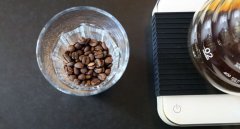Coffee tasting and describing the defective flavor of coffee what is the taste defect of potato?
Potato defects in coffee, also known as potato taste defects, or PTD, occur in coffee in Rwanda, western Uganda, Burundi and the Democratic Republic of the Congo.
It smells and tastes like the name: raw potatoes.
The visual recognition rate associated with PTD defective seeds (or coffee beans) is very low, if any. In fact, most defective seeds look perfectly normal to the human eye, with no visible pests or ultraviolet fluorescence.
Therefore, unlike other defects, there is no "preventive maintenance" in the treatment or classification method, which manufacturers can do to ensure a high reduction rate of PTD. However, there is a smell associated with this defect and is easily identified in freshly ground roasted coffee.
In our study that followed PTD, the average incidence of this defect was 1550g. This means that every 3.3lb or so, the chances of hitting a PTD seed (coffee bean) are quite high. It also means that the chances of potato defects in a 12-ounce bag are low. Of course, there is a lot of randomness, which is the nature of wild animals. The defect itself has no known toxicity, and if you encounter it after brewing, it is safe. However, since a defective bean can affect the taste of brewed coffee beans, we will share our suggested steps to avoid tasting potatoes.

The recommended solutions for avoiding coffee potato defects are as follows:
1. When preparing these coffees for any brewing method, be sure to smell the ground coffee carefully before brewing.
2. If possible, use a small amount of ground coffee instead of grinding a whole bag of coffee at once.
3. For home brewing, we recommend that each grinding
Important Notice :
前街咖啡 FrontStreet Coffee has moved to new addredd:
FrontStreet Coffee Address: 315,Donghua East Road,GuangZhou
Tel:020 38364473
- Prev

Ratio of freshly ground coffee powder to water Coffee basics: brewing ratio-how much water and coffee to use
For brewing coffee water and powder, we recommend a ratio of 1:17. At 1:17, for every gram of coffee, use 17 grams of water. This provides the best opportunity for ideal extraction, that is, the soluble flavor of coffee grounds dissolves in water and is complementary. This ratio is the best for manual and automatic dumping methods. As you may have noticed, we suggest that our ratio
- Next

The best time to drink coffee the basics of coffee: explore freshness-how to keep coffee fresh?
You probably know that the freshness of coffee has an effect on the taste. Admittedly, freshness is a sign of specialty coffee and one of the main factors that attract many people to explore what the coffee industry has to offer. But what do people mean when they say freshness is important? What do you mean the coffee is fresh? How freshness affects the coffee you drink at your local coffee shop or home
Related
- Beginners will see the "Coffee pull flower" guide!
- What is the difference between ice blog purified milk and ordinary milk coffee?
- Why is the Philippines the largest producer of crops in Liberia?
- For coffee extraction, should the fine powder be retained?
- How does extracted espresso fill pressed powder? How much strength does it take to press the powder?
- How to make jasmine cold extract coffee? Is the jasmine + latte good?
- Will this little toy really make the coffee taste better? How does Lily Drip affect coffee extraction?
- Will the action of slapping the filter cup also affect coffee extraction?
- What's the difference between powder-to-water ratio and powder-to-liquid ratio?
- What is the Ethiopian local species? What does it have to do with Heirloom native species?

